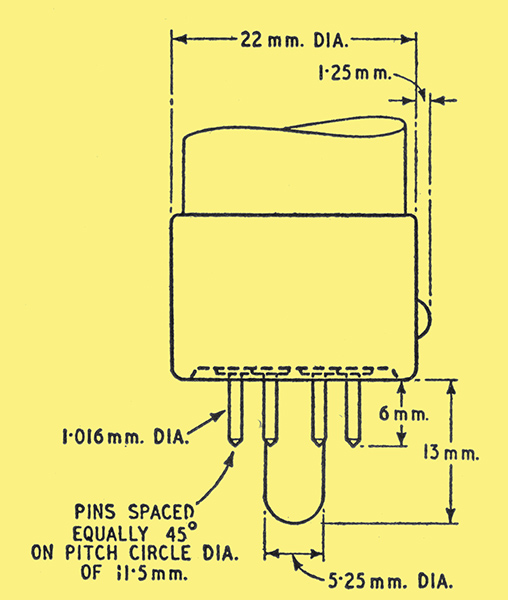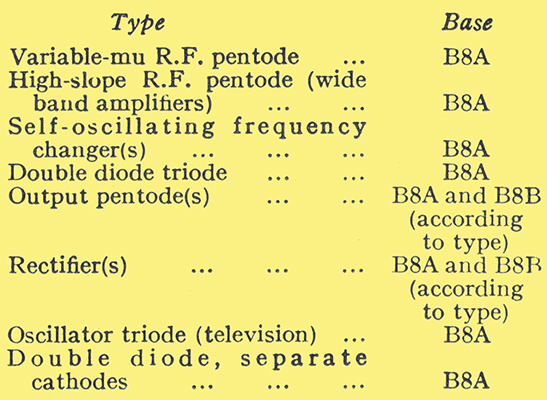|
See alsoThe EF91 - not the valve that won the war.
Significant Progress Has Been Made
Speaking before the Radio Industries Club on Tuesday, May 28th, J W Ridgeway, OBE, dealt with a matter of the utmost importance to all branches of radio: his principal topic was the vexed question of valve standardization. This subject is one which has been debated in technical circles, including the columns of this journal, almost since radio began and Mr Ridgeways address was therefore bound to arouse the greatest interest. He is a director of Edison Swan, and also chairman of the British Radio Valve Manufacturers Association.
The talk stressed one point which should be generally accepted but which is too frequently overlooked: namely, that the standardization of so complicated an engineering product as a radio valve is a task of almost overwhelming difficulty. It is not sufficient that a group of engineers should sit round a table to work out an ideal standard valve; if that were all the problem would have disappeared years ago. In practice one has to take into account the different" manufacturing techniques in the factories of different manufacturers and the different needs and practices of all the countless valve users. Also there is the extremely complex situation resulting from differing commercial policies and differing commercial needs consequent upon the marketing, or the desire to market, radio valves in all the different countries of the world. This list of obstacles would be formidable enough by itself, but it has to be seen against a background of the disorganization of the war years.
Despite all this, Mr Ridgeway was able to report that the valve manufacturers who constitute the membership of the British Radio Valve Manufacturers Association had undertaken a serious study of the whole problem of valve standardization. This start had been made at a time when the demands of war had been at their peak but, nevertheless, very marked progress had already been made. The valve manufacturers had set themselves the task of developing a range of valves 'capable of manufacture by each of the member manufacturers using his own technique and methods of construction, but the working characteristics of which would be such that valves of any one type were freely interchangeable in the appropriate socket in domestic apparatus without significant change in the performance of the apparatus concerned. That was the ultimate goal before the manufacturers, and when reached it would provide all the advantages which were so frequently claimed for a true standard range of valves. In addition, however, it would provide something more, since this policy laid down that the various valve types would be capable of manufacture by the various manufacturers using their own techniques and method of construction. In this way the most serious risk of standardization would be avoided, that risk being the danger of stagnation by the elimination of the skill and individuality of competing manufacturers.
In working towards this target it had been seen that the first step was to adopt a base, or bases, acceptable to all the valve manufacturers concerned. This had been done, and the valve manufacturers had been determined that the bases adopted should incorporate the most recent advances in the art so that the range of valves to follow could be as efficient as possible. It had been found desirable to adopt two standard bases: one which offered the maximum possible saving in space (consistent with technical performance) and was satisfactory for valves of smaller dissipations, and the other for those larger valves such as certain rectifiers and power output types where more dissipation was required. On the score of size as well as of technical considerations, it had been considered necessary that both designs should embody what is commonly known as the 'all-glass technique'. These bases had been agreed.
In addition to this major step Mr Ridgeway disclosed that the valve manufacturers had also practically completed a scheme of standardised pin connections for use on the two standard bases. The next step was to agree upon the valve types which were to be included within the standard range and to work out common specifications which the BVA members could all accept and which would enable them to produce standard interchangeable valves.
Mr Ridgeways address was the first public intimation of the programme which the BVA manufacturers had set themselves. Those directly concerned, such as the set-making side of the Radio Industry and, of course, the service establishments, have known of this programme for some time, but it has never been overlooked that the wider technical public is vitally interested, too.
Vast numbers of users of valves have been concerned at the wide diversity of types and consequent difficulty in replacement which have grown up over the years of radios rapid advancement, while those whose business it is to sell radio valves have despaired of the difficulty of maintaining full and representative stocks of so widely diverse a product. All these people will be cheered to know that this crying need has not been overlooked by the BVA manufacturers, and that they have set themselves the task of working towards a true standard range of British valves and that they have already made very significant progress towards this end. What is perhaps more important is the attempt to achieve that objective without sacrificing the individuality of the separate manufacturers. The co-existence of different valve designs and production techniques is an essential element in the technical advancement of radio as a whole, and that could not be maintained if standardization were effected by a slavish copying of some one range produced elsewhere or by a standardization which was so rigid that diversity of technique and the progress which follows in its train were eliminated.
Valve Standardisation: First Steps by the BVA
The next section comes from the November, 1946 issue of Wireless World.
Discussion is still proceeding on the types and characteristics of the valves which will be included in the new standard range to be produced by the British Radio Valve Manufacturers Association. In the meantime a sufficient measure of agreement has been reached on the physical dimensions of the bases which will be used for some details to be published. The BVA emphasizes that the proposals are tentative, but it is thought that any future modifications will be of a minor character.
The first point of interest is that the bases will be of all-glass construction in which thin solid pins are sealed directly into bosses in the glass base.

Most of the new standard types will have an entirely new small eight-pin base (type B8A) with a central spigot and a locating boss on the side of the shell. A bayonet-type valve holder will be required and a side elevation of the new base is shown in the drawing. Where a valve with a large bulb is required, as in the case of output valves and power rectifiers with higher heat dissipation, a larger base (type B8B) will be used. The dimensions of this base are similar to the existing eight-pin Loctal base, and from a tentative schedule of pin connections for use with all BVA valves it would appear that existing conventions have been followed.
Tentative base allocations for the proposed BVA standard valves are as follows:

Comment from February 1947 letters
After several weeks of trepidation concerning the latest BVA moves at valve standardization, I was greatly encouraged by J Sparrows letter in your January issue. I share his views on yet another awkward and irritating addition to an engineers troubles. 'Standard' seems a very optimistic word to use for the new valve base, especially when it has to be divided into two types to accommodate the normal range of valves. Surely a very convenient and practical base type has been evolved for us by the widespread success of the international octal base. Such a base will accommodate a large variety of valves without requiring different sizes of holders. The new standard, using a bayonet-type valve holder, on the other hand, limits the diameter of the base within close limits unless recourse is had to the use of different size holders.
The point that seems to be most difficult to understand is the necessity for placing the locating boss on the side of the shell, instead of on the spigot; and thus having to use a bayonet-type base. See B8A
With the very lengthy spigot and the bayonet-type base, more head-room will be required above the valve for the removal and replacement than need be. This does not seem helpful when considering the compact apparatus designers promise in the future.
The international octal base has been very successful, and the 'international' quality ought to be an important point in these post-war days of high exports. The vast majority of service equipment uses the international octal, and this base is also appearing in many new sets.
Why not adopt that which experience has shown to be acceptable, simplify all our present valve types into a standard range, and make an important step towards progress?
As it is, wireless dealers will have to add yet another shelf for their valve stocks, Wireless World another page to its 'Valve Data', and the enthusiast will have a still larger collection of oddities to choose from!
London, W5. R G Parr.
Change to B8A Specification
The next section comes from the May, 1947 issue of Wireless World.
Details of the new 8-pin base of pressed glass construction introduced by the British Valve Manufacturers Association appeared in Wireless World November, 1946. Since then an alternative version of the Type B8A base has been agreed; the centre spigot may be omitted in some cases, though it will be necessary to continue to provide a centre hole in all B8A valve-holders in order that they may accommodate either type. The raised boss on the side of the valve base will continue to be used in both types to locate the valve pins correctly in the base.
|